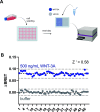Class-Wide Analysis of Frizzled-Dishevelled Interactions Using BRET Biosensors Reveals Functional Differences among Receptor Paralogs
- PMID: 39213612
- PMCID: PMC11443525
- DOI: 10.1021/acssensors.4c00806
Class-Wide Analysis of Frizzled-Dishevelled Interactions Using BRET Biosensors Reveals Functional Differences among Receptor Paralogs
Abstract
Wingless/Int-1 (WNT) signaling is mediated by WNT binding to 10 Frizzleds (FZD1-10), which propagate the signal inside the cell by interacting with different transducers, most prominently the phosphoprotein Dishevelled (DVL). Despite recent progress, questions about WNT/FZD selectivity and paralog-dependent differences in the FZD/DVL interaction remain unanswered. Here, we present a class-wide analysis of the FZD/DVL interaction using the DEP domain of DVL as a proxy in bioluminescence resonance energy transfer (BRET) techniques. Most FZDs engage in a constitutive high-affinity interaction with DEP. Stimulation of unimolecular FZD/DEP BRET sensors with different ligands revealed that most paralogs are dynamic in the FZD/DEP interface, showing distinct profiles in terms of ligand selectivity and signal kinetics. This study underlines mechanistic differences in terms of how allosteric communication between FZDs and their main signal transducer DVL occurs. Moreover, the unimolecular sensors represent the first receptor-focused biosensors to surpass the requirements for high-throughput screening, facilitating FZD-targeted drug discovery.
Keywords: Dishevelled; Frizzled; GPCR; WNT; bioluminescence resonance energy transfer; class F; transducer.
Conflict of interest statement
The authors declare no competing financial interest.
Figures




Similar articles
-
WNT-induced association of Frizzled and LRP6 is not sufficient for the initiation of WNT/β-catenin signaling.Nat Commun. 2025 May 24;16(1):4848. doi: 10.1038/s41467-025-60096-7. Nat Commun. 2025. PMID: 40413190 Free PMC article.
-
WNT stimulation induces dynamic conformational changes in the Frizzled-Dishevelled interaction.Sci Signal. 2023 Apr 4;16(779):eabo4974. doi: 10.1126/scisignal.abo4974. Epub 2023 Apr 4. Sci Signal. 2023. PMID: 37014927
-
Structural basis of Frizzled 4 in recognition of Dishevelled 2 unveils mechanism of WNT signaling activation.Nat Commun. 2024 Sep 2;15(1):7644. doi: 10.1038/s41467-024-52174-z. Nat Commun. 2024. PMID: 39223191 Free PMC article.
-
The Frizzled family of unconventional G-protein-coupled receptors.Trends Pharmacol Sci. 2007 Oct;28(10):518-25. doi: 10.1016/j.tips.2007.09.001. Epub 2007 Sep 19. Trends Pharmacol Sci. 2007. PMID: 17884187 Review.
-
WNT/Frizzled signalling: receptor-ligand selectivity with focus on FZD-G protein signalling and its physiological relevance: IUPHAR Review 3.Br J Pharmacol. 2014 Mar;171(5):1195-209. doi: 10.1111/bph.12364. Br J Pharmacol. 2014. PMID: 24032637 Free PMC article. Review.
Cited by
-
WNT-induced association of Frizzled and LRP6 is not sufficient for the initiation of WNT/β-catenin signaling.Nat Commun. 2025 May 24;16(1):4848. doi: 10.1038/s41467-025-60096-7. Nat Commun. 2025. PMID: 40413190 Free PMC article.
-
A Putative Frizzled 7-Targeting Compound Acts as a Firefly Luciferase Inhibitor.J Med Chem. 2024 Dec 26;67(24):22332-22341. doi: 10.1021/acs.jmedchem.4c02766. Epub 2024 Dec 13. J Med Chem. 2024. PMID: 39670643 Free PMC article.
References
Publication types
MeSH terms
Substances
LinkOut - more resources
Full Text Sources

